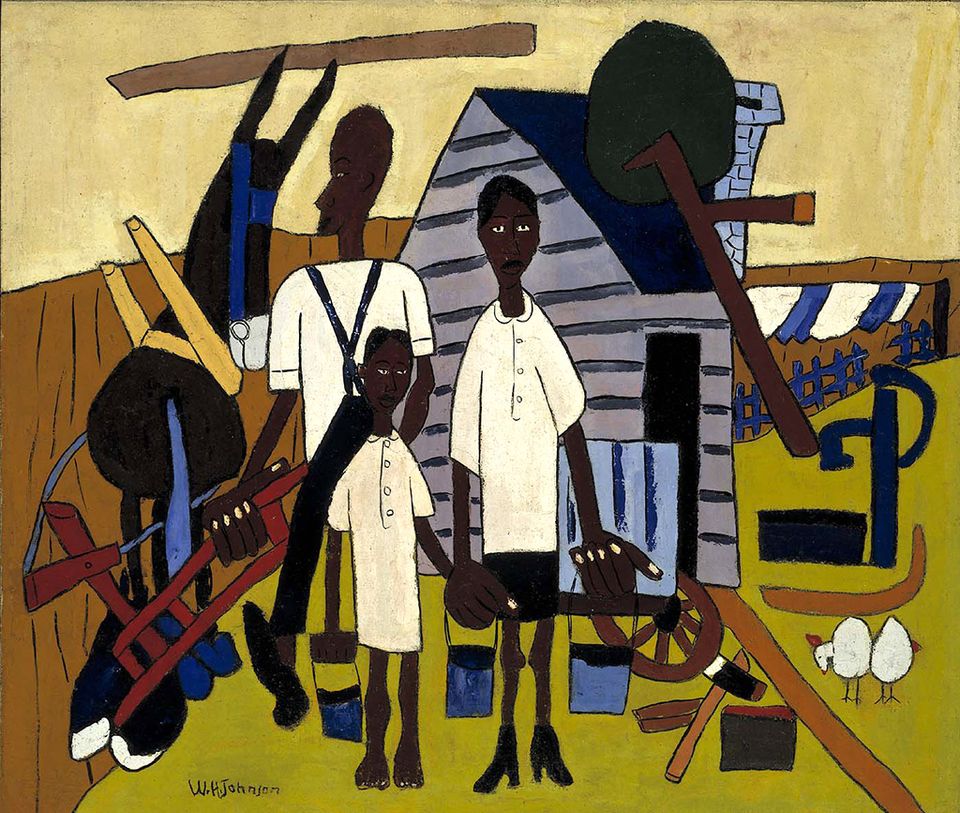

In honor of Elizabeth "Betsy" Broun's nearly thirty years at the helm of the Smithsonian American Art Museum and her imminent retirement, Broun spoke to a full house at the McEvoy Auditorium this past October, revealing insights and personal observations about her favorite works of art in SAAM's collection. And since she's the director, her Top Ten contains eighteen artworks. Last month, we posted the first part of her "Top Ten." Today, we are posting the rest on her list of favorites.
The lives of African Americans, women, and the Whitmanesque vistas of the American landscape rounded out SAAM director Betsy Broun's presentation of her favorite works of art in our museum's collection.
The discussion of three African American artists representing vastly different times in our nation's history began with William H. Johnson. His colorful, vibrant works portraying faith and family are well represented at SAAM. Born in 1901 in South Carolina, when "Jim Crow was alive and well," Johnson moved to New York at the age of 17, before temporarily relocating to Europe to study with some of the masters, including Chaim Soutine. In terms of Johnson's style, Broun told us that "Instead of being a slashing modernist, he simplified, and adopted a naïve, folk-art style" that is evident in many paintings including Early Morning Work. Johnson's life assumed a tragic arc late in life and his works—many in poor condition— were almost destroyed in a warehouse in New York City. "Nobody wanted them. The surrogate court ordered the collection destroyed. And then the Smithsonian stepped in. Instead of destroying them all, they came to our museum. When I think of how close this artist came to having his life work destroyed, it makes me realize the heavy weight of responsibility we have here to make sure that important artists find a friend in us and take a stand—he was unknown, and had no reputation or advocates. Long story short, it's a call to conscience for our museum and many others."
Fast forward to the 1950s and James Hampton's visionary, The Throne of the Third Heaven of the Nations' Millennium General Assembly aka The Throne. This monumental work of art, praised by art critic Robert Hughes as the most important piece of visionary art ever made in this country, is currently on view with additional elements in the reimagined Folk and Self-taught galleries. "We still don't understand this work altogether, either," Broun told us, "Why was he doing this? Was he going to open a storefront church? Was it simply a private devotional enterprise? We do not understand. It is a spectacular achievement made from some of the most humble materials." And as with William H. Johnson's oeuvre, this work was destined for the dustbin until it was saved by folks in Washington. "We're lucky to have this one, too."

Mickalene Thomas' Portrait of Mnonja
Mickalene Thomas' Portrait of Mnonja, created in 2010, is "dramatic, sensual, and huge. It's kind of flashy. All of these are things for so long denied to women and to black people and here she is doing this dazzling image of empowerment." Mnonja reclines like a classical nude, and made Broun's list for it's embodiment of affirmation and power. "It feels so different from all the artworks where you have to tell a sad story to go along with it. Not with this one. Mickalene is on top of the world."
The discussion of Thomas's work led to a look at a selection of women portrayed in the collection over time, some on top of the world, some redefining their world, and others seemingly trapped. This included the solitary woman in the iconic Edward Hopper painting Cape Cod Morning from 1950 who may be a stand-in for all American women after World War II who were forced to return home after playing a crucial role in the workforce. About 25 years later and in the early years of Ms. Magazine, Martha Rosler created Semiotics of the Kitchen, an early form of video art where the artist uses the tools in her kitchen to create a kind of alphabet of feminism. From there, the discussion led to Viola Frey's nine-foot-tall woman, Lady in Blue and Yellow Dress, which towers over everyone and everything.
The talk concluded with works by George Catlin (an artist she greatly admires), Emanuel Leutze (whose Westward the Course of Empire Takes Its Way (mural study, U.S. Capitol) with its panel of the Golden Gate, reminded us of Christo and Jeanne-Claude's monumental and expansive outdoor work, Running Fence), Ray Strong's bold image of the construction of the Golden Gate Bridge, and Wayne Thiebaud's Levee Farms, which Broun praised for its "positive view of the future that is in some ways uniquely American." In these last works there was a sense of optimism and a belief in America's sense of freedom and expansiveness and a "confident willingness to march forward in the future." Where will our journeys take us?
Broun concluded her talk by reading a section from Walt Whitman's great, "Song of the Open Road," ending with the words, "All seems beautiful to me," the same message she found in the works of art she shared with us.

















